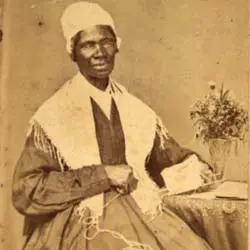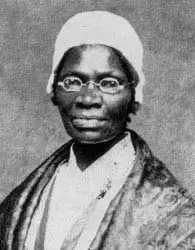Sojourner Truth
Truth was born Isabella Baumfree in 17971 and born into a slave family in New York. She was sold at 11 years old along with a herd of sheep for $100. She suffered abuse as a slave and escaped to freedom, taking her infant daughter with her. She became an avid voice for the freedom of slaves and women’s rights and this was unusual during a time when neither Black Americans, but especially not Black American women spoke up. She decided to take the self-given name of Sojourner Truth in 1843.


Sojourner’s life as a young woman and a slave didn’t allow her to marry the man, also a slave that she loved. Instead, her owner made her marry another slave. Truth was one of the most powerful people in the abolitionist movement and when the State of New York freed all of the slaves in 1827, she became a vocal member to carry the message of freedom. When she found out that her son, whom she had left behind, had been sold to another slave owner, she became the first Black woman to take the case to court and eventually secured the release of her son.

Truth joined organizations in 1844 that supported both abolitionist’s beliefs and women’s rights, including the Northampton Association of Education and Industry in Massachusetts. All of the members lived in a self-sufficient community on 500 acres. During this time, Truth also met other leading abolitionist leaders including Frederick Douglass, William Lloyd Garrison and David Ruggles. Garrison, who published the activist newspaper, published Truth’s memoirs in 1850 with the title: “The Narrative of Sojourner Truth: A Northern Slave”. Since she could not read or write, she dictated the story to a writer.

During this same time, Sojourner began touring at speaking engagements, including the first National Women’s Rights Conventions in Massachusetts and accompanied abolitionist George Thompson, where they spoke to large groups of people on human rights and slavery. Truth became one of the few well-known former slaves to rise to popularity along with Harriet Tubman and Frederick Douglass, who spoke out on the topic of enslaved people.


It was in 1851 that Truth attended the Ohio Women’s Rights Convention in Akron and gave her famous speech “Ain’t I a Woman?”. The speech was published in a number of anti-slavery publications, but without the famous title itself. She became a well-known individual during this time and made use of it when the Civil War took over the attention of the country, acting to recruit Black Americans to fight for the cause of freedom for the North.

She contributed to the National Freedman’s Relief Association in Washington, D.C. and met with President Lincoln on at least one occasion, sharing her experiences and beliefs. Even after the Emancipation Proclamation was enacted by President Lincoln, Sojourner continued to call to action the belief that all Americans should have the right to own property and the desegregation methods that were needed in public transportation.

Truth spent her life committed to the concept of freedom for all and became one of the most outspoken women for women’s rights as well as prison reform.




